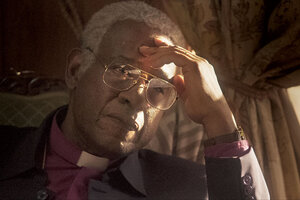In ‘The Forgiven,' Desmond Tutu faces off with a white separatist
The film’s strength lies in the dialogue between the characters, portrayed by Forest Whitaker and Eric Bana.

Forest Whitaker plays Desmond Tutu in 'The Forgiven.'
Courtesy of Saban Films
An intermittently powerful drama loosely derived from real events, Roland Joffé’s “The Forgiven” takes place in newly post-apartheid South Africa and is based on a play by Michael Ashton called “The Archbishop and the Antichrist.”
The archbishop is Desmond Tutu (Forest Whitaker), who was chair of the Truth and Reconciliation Commission (TRC), which sought to investigate the brutal politically inspired abuses committed during the apartheid years. The perpetrator must confess to the crime. Forgiveness for the crime is sometimes paired with legal amnesty from prosecution. Restitution could be made to the victims of the crime.
The antichrist is Piet Blomfeld (Eric Bana), an unregenerate white separatist with a history of apartheid-era violence who is doing major time in Pollsmoor Prison. In an attempt to avail himself of the TRC, he writes a letter to Tutu riddled with references to Plato and Milton, figuring this will get the archbishop’s attention. It does, and soon a meeting between the two is arranged in prison.
Their dialogue over several meetings is the intense core of the conflict in “The Forgiven” and by far its strongest aspect. It’s clear in these scenes that we are watching a filmed play. It’s also clear that none of that matters. Joffé understands that, if what we are watching is indeed worth watching, the best way to be “cinematic” is often to simply fix the camera on the protagonists without a lot of fancy folderol.
In their first meeting, Tutu, who has already been shown to be a preternaturally patient man of faith, is confronted by a man who grinningly hurls racial epithets at him and scoffs at the archbishop’s attempts to salvage his soul. Tutu believes that no man is beyond redemption. Blomfeld, his eyes sparked with hate, believes he has done nothing for which he should be redeemed.
Tutu’s associates had warned him away from Blomfeld, but he persists, despite being shadowed by private misgivings that the convict is beyond reach. The reason the serial encounters between these two men hit home is because Blomfeld’s inevitable change of heart is presented with a fine degree of complexity. He doesn’t change overnight; in many respects, he changes hardly at all. But as the film progresses, it unfolds a back story to his racism that, while not condoning his actions, at least supports the notion that he is capable of salvation.
I would contrast Blomfeld’s progression from arrant racist to (sort of) rehabilitated good guy with the way the racist deputy played by Sam Rockwell is portrayed in the overrated “Three Billboards Outside Ebbing, Missouri.” In that film, Rockwell’s deputy is also “rehabilitated,” but in a way that never really accounts for the vileness of his actions, such as the torturing of a black prisoner. Because Rockwell is a jaunty, funny actor, his portrayal has a sympathy it doesn’t earn – or deserve.
Contrast this with Bana’s unyielding portrayal in “The Forgiven.” No attempt is made to win over the audience. This welcome absence of sentimentality allows us to experience Tutu’s own crisis of faith as he attempts to reconcile this man’s actions with his bedrock belief in forgiveness. Bana’s terrific performance is really a duet: Without Whitaker’s nuanced work, it would not have been possible.
The most powerful scene in the movie, and the one that most fully encompasses its meaning, belongs to Mrs. Morobe (the marvelous Thandi Makhubele), a mother who has pleaded with Tutu to uncover the circumstances behind the likely murder of her teenage daughter. When those circumstances finally come to light at a TRC hearing and she confronts the perpetrator, her blinding rage and sorrow come pouring through and you ask yourself how this woman will ever find it in herself to forgive. And yet she does, and in a way that most of us could never believe ourselves capable of. Before our eyes, and by her furious grace, she unshackles herself. Grade: B+ (Rated R for disturbing/violent content and language throughout, including some sexual references.)

